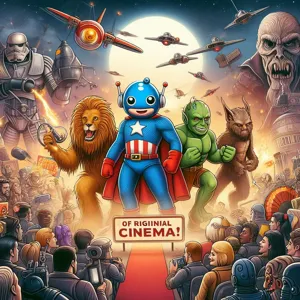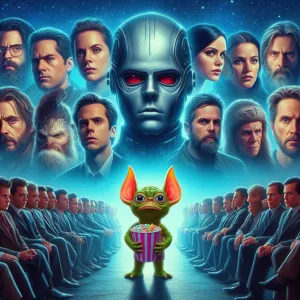In an era where cinematic universes reign supreme and familiar titles dominate the box office, the question looms large: is franchise fatigue stifling creativity in Hollywood? As audiences flock to theaters for yet another sequel, prequel, or spin-off, the once-thrilling allure of original storytelling appears to be fading into the background.
This blog post delves into the phenomenon of franchise fatigue, exploring how the relentless pursuit of profitability and the comfort of established brands may be overshadowing innovative, fresh narratives. We’ll examine the impact of this trend on filmmakers, screenwriters, and, most importantly, viewers, as we seek to understand whether the endless cycle of reboots and sequels is a testament to a lack of imagination or simply a reflection of what audiences demand. Join us as we unpack the complexities of this issue and ponder the future of creativity in an industry increasingly defined by its past.
1. Introduction to Franchise Fatigue

In recent years, the cinematic landscape has witnessed a palpable shift, with the dominance of franchise films reshaping not only box office numbers but also the creative fabric of Hollywood. This phenomenon, often referred to as “franchise fatigue,” has sparked intense debate among filmmakers, critics, and moviegoers alike. As studios increasingly lean on established properties—be it beloved comic book heroes, nostalgic animated classics, or iconic horror series—the question arises: are these sequels, reboots, and spin-offs stifling originality and innovation in filmmaking?
Franchise fatigue manifests itself in various ways. Audiences, once eager to devour the next installment of their favorite series, now find themselves grappling with a sense of déjà vu, as familiar plots and character arcs begin to meld into a homogenized cinematic experience. The excitement of discovering new stories is often overshadowed by the relentless barrage of predictable narratives that follow a tried-and-true formula. The reliance on established franchises, while financially lucrative, raises concerns about the long-term implications for creative storytelling.
Moreover, the sheer volume of content churned out by studios in pursuit of the next blockbuster can be overwhelming. As fans are bombarded with sequels and spin-offs, the unique voices of emerging filmmakers risk being drowned out, leading to a landscape where creativity is sacrificed for commercial viability. This introduction to franchise fatigue sets the stage for a deeper exploration of its impact on the industry, the artistry involved, and the potential paths forward for a Hollywood seeking to balance nostalgia with innovation.
2. The Rise of Movie Sequels and Franchises
In recent years, the cinematic landscape has been dominated by a burgeoning trend: the rise of movie sequels and franchises. Once a novelty reserved for select blockbusters, sequels have rapidly evolved into a staple of Hollywood’s production strategy, driven largely by the allure of established audiences and the promise of guaranteed box office returns. This phenomenon is evident in the staggering number of franchises that have emerged from beloved films, spawning sequels, prequels, and spin-offs at an unprecedented rate.
Take, for instance, the Marvel Cinematic Universe, which has redefined the blockbuster format by interconnecting a multitude of characters and storylines across an expansive series of films. With each new installment, fans are met with a familiar universe teeming with nostalgic elements, yet this reliance on prior successes can stifle originality. Similarly, franchises like “Star Wars” and “Jurassic Park” continue to expand, attempting to capture the magic of their originals while often falling prey to recycled plots and predictable character arcs.
This relentless pursuit of profitability through sequels raises important questions about the impact on creativity in Hollywood. As studios prioritize projects that promise quick returns, there is a growing concern that innovative storytelling is being sacrificed on the altar of franchise expansion. Screenwriters and directors, once seen as the architects of unique cinematic visions, now find themselves navigating a landscape dominated by the fiscal demands of established brands. The result? A cinematic culture where creativity is often overshadowed by the need to meet the expectations of a franchise-hungry audience, leading to a repetitive cycle that may ultimately diminish the art of filmmaking itself.
In this context, the question arises: are we witnessing a golden age of nostalgic entertainment, or are we, instead, trapped in a cycle of franchise fatigue that threatens to stifle the very creativity that made Hollywood great? As audiences continue to flock to theaters, the answer may lie in our willingness to embrace new narratives while still celebrating the classics.
3. Historical Context: A Brief Overview of Sequels in Cinema

To understand the current landscape of franchise fatigue in Hollywood, it’s essential to look back at the historical context of sequels in cinema. The practice of extending a film’s narrative through sequelization is not a new phenomenon; it dates back to the early days of filmmaking. One of the first notable sequels was “Trusting the Future,” which premiered in 1914, but it wasn’t until the late 20th century that sequels began to proliferate as a dominant trend in the industry.
The 1970s marked a pivotal moment with the release of iconic sequels like “The Godfather Part II” (1974), which not only garnered critical acclaim but also demonstrated that sequels could stand shoulder to shoulder with their predecessors in terms of storytelling and artistry. This era laid the groundwork for what would become a lucrative formula, paving the way for franchises. The 1980s and 1990s saw an explosion of sequels across various genres, from action-packed blockbusters like “Die hard 2” (1990) to family-friendly fare such as “Home Alone 2: Lost in New York” (1992). Studios began to recognize the financial potential of capitalizing on established narratives and beloved characters, leading to a wave of sequels designed primarily for box office success.
As we moved into the 21st century, the trend escalated with franchises like “Harry Potter,” “The Marvel Cinematic Universe,” and “Star Wars” dominating the cinematic landscape. These franchises not only produced sequels but also expanded into spin-offs, prequels, and crossovers, creating a web of interconnected stories that kept audiences returning for more. While this approach has generated significant revenue, it has also sparked debates about the creative stagnation it may cause, as studios often prioritize safe investments over innovative storytelling.
In recent years, however, audiences have begun to express fatigue, questioning the artistic integrity of a system that seems to favor familiar narratives over fresh ideas. The once-celebrated sequel has evolved into a double-edged sword: a financial powerhouse that simultaneously risks diluting creativity and originality within the film industry. As we navigate this complex terrain, it becomes increasingly important to consider the implications of franchise fatigue and what it means for the future of cinema.
4. The Economic Factors Behind Franchise Development
The film industry has long been a battleground where creativity and commerce clash, but nowhere is this more evident than in the realm of franchise development. The economic factors driving studios to churn out sequels and spin-offs are complex and multifaceted, reflecting broader trends in consumer behavior, technological advancements, and market dynamics.
At the heart of this phenomenon lies the undeniable allure of guaranteed returns. A successful franchise provides studios with a built-in audience, reducing risk in an industry notorious for its unpredictability. When a film performs well at the box office, studios are quick to capitalize on that success, greenlighting sequels and expanding the universe with spin-offs. This approach not only ensures a steady revenue stream but also allows for cost-effective marketing strategies—after all, why spend millions introducing a new concept when you can leverage the existing fanbase of a beloved character or story?
Additionally, the rise of streaming services has shifted the economic landscape, creating an insatiable demand for content. Platforms like Netflix, Disney+, and Amazon Prime are constantly seeking new material to keep subscribers engaged. This pressure has intensified the focus on franchises, as studios can repurpose existing intellectual property into various formats—think movies, television series, merchandise, and even theme park attractions. The more a franchise can be monetized across different platforms, the more enticing it becomes to executives looking to maximize profits.
Moreover, the global market plays a crucial role in franchise development. As more films are released internationally, studios often prioritize projects with universal themes and recognizable characters to appeal to a diverse audience. This global perspective can lead to a homogenization of storytelling, as studios may shy away from unique or experimental ideas in favor of tried-and-true formulas that guarantee box office success around the world.
While these economic factors undeniably contribute to the proliferation of sequels and franchises, they also raise critical questions about the future of creativity in Hollywood. Are studios sacrificing innovative storytelling in favor of financial security? As audiences become inundated with familiar faces and recycled plots, will we lose the originality that once defined cinematic storytelling? The answers to these questions may ultimately shape the future of film, as the balance between commerce and creativity remains a delicate dance in the ever-evolving landscape of Hollywood.
5. Audience Demand: What Viewers Want vs. What They Get

In the ever-evolving landscape of Hollywood, a palpable tension simmers between audience demand and the offerings that flood the silver screen. On one hand, we have a discerning public that craves fresh narratives and innovative storytelling; on the other, studios often lean heavily on the familiar and formulaic. The question arises: are filmmakers truly listening to what viewers want, or are they simply serving up a buffet of sequels, reboots, and franchise extensions in hopes of capitalizing on established fan bases?
The numbers tell a compelling story. Blockbusters often dominate the box office, with franchises boasting built-in audiences that guarantee initial ticket sales. Yet beneath this veneer of success lies a growing discontent. Many viewers express frustration over the lack of originality, yearning for unique stories that spark conversations and emotional connections rather than just nostalgia. Social media platforms buzz with opinions as fans critique the latest installment of beloved franchises, often lamenting how far the sequels stray from the essence of the original films.
This disconnect highlights a critical challenge for filmmakers and studios alike: the balance between commercial viability and creative integrity. While it’s tempting to churn out sequels that leverage existing characters and plots, the risk is alienating the very audience they seek to captivate. Viewers are more perceptive than ever, and they can sense when a sequel feels like a cash grab rather than a genuine extension of a beloved story. In this climate, the call for originality grows louder, urging Hollywood to reexamine its approach and elevate fresh voices and ideas.
Ultimately, the landscape of audience demand is nuanced, with viewers seeking both familiarity and innovation. As Hollywood grapples with franchise fatigue, understanding this delicate balance may hold the key to reigniting the spark of creativity and delivering the stories that audiences genuinely crave. Will studios heed this call, or will they continue to prioritize the safety of the sequel over the boldness of original storytelling? The answer may well determine the future of cinema itself.
6. The Impact of Franchise Fatigue on Original Content
As audiences increasingly gravitate toward familiar franchises and beloved characters, the impact of franchise fatigue on original content becomes ever more pronounced. In an industry that thrives on box office numbers and streaming statistics, studios are prioritizing sequels, reboots, and spin-offs over fresh narratives and original ideas. This trend raises a pressing question: at what cost?
The saturation of franchise films can stifle creativity, leading to a homogenized cinematic landscape where risks are seldom taken. Filmmakers may feel compelled to conform to established formulas, crafting stories that play it safe rather than exploring bold, innovative concepts. This not only limits artistic expression but also diminishes the diversity of stories being told. When the majority of screen time is devoted to well-worn franchises, unique voices and perspectives struggle to find a platform, leading to a cinematic echo chamber.
Moreover, as audiences become conditioned to expect sequels and interconnected universes, original content often faces an uphill battle in capturing attention. New stories, brimming with potential, can be overshadowed by the latest installment of a franchise, resulting in a lack of visibility and investment. This creates a cycle where studios are less willing to take a chance on originality, further entrenching the dominance of franchises in Hollywood.
The consequences of this trend extend beyond the immediate financial implications. Original films are vital for cultural discourse and innovation within the medium. They challenge societal norms, introduce new ideas, and inspire future generations of creators. With franchise fatigue setting in, the industry risks losing the very essence that makes cinema a dynamic and evolving art form.
In a world saturated with familiar narratives, it’s essential for studios to recognize the value of original content. By fostering an environment that celebrates creativity and embraces new stories, Hollywood can revitalize its storytelling landscape and reignite the passion of audiences eager for fresh experiences. The challenge lies in balancing the allure of established franchises with the necessity of nurturing original narratives, ensuring that creativity thrives alongside commercial success.
7. Case Studies: Successful vs. Failed Sequels
In the ever-evolving landscape of Hollywood, the impact of sequels on creativity can be illuminated by examining both successful and failed franchises. These case studies reveal not only the nuances of audience reception but also the underlying factors that contribute to a sequel’s triumph or downfall.
Take, for instance, the resounding success of “Mad Max: Fury Road” (2015). This film, a sequel to the original “Mad Max” series from the late 1970s and early 1980s, reinvigorated the franchise with a bold, visually stunning narrative that pushed the boundaries of action cinema. Director George Miller crafted a story that was not just a visual spectacle but also rich in themes of survival, resilience, and feminism. The film’s ability to balance nostalgia with innovative storytelling allowed it to resonate with both longtime fans and a new generation, demonstrating that sequels can thrive creatively when they take risks and offer fresh perspectives.
On the flip side, consider “Transformers: Age of Extinction” (2014), a sequel that struggled to capture the magic of its predecessors. While the original “Transformers” film (2007) was a groundbreaking blend of special effects and storytelling that captivated audiences, subsequent sequels increasingly relied on explosive action and complex narratives that felt disjointed. Critics noted that “Age of Extinction” lacked the charm and coherence that made the first film a hit, resulting in a fatigued audience that had grown weary of the franchise’s repetitive formula. This case exemplifies how a failure to innovate and engage with the audience’s evolving tastes can lead to a sequel’s demise.
As we dissect these contrasting examples, it becomes clear that the key to a successful sequel lies not only in leveraging the established brand but also in infusing it with originality and relevance. The balance between honoring the legacy of a franchise and exploring new creative avenues is delicate, yet crucial for sustaining interest and enthusiasm in a landscape increasingly dominated by franchise fatigue. In this ongoing debate, these case studies serve as reminders that while sequels can often yield financial success, the true measure of creativity lies in their ability to inspire, challenge, and engage audiences in meaningful ways.
8. The Role of Streaming Services in Franchise Culture
In recent years, streaming services have emerged as powerful players in the entertainment landscape, profoundly influencing franchise culture in Hollywood. As platforms like Netflix, Disney+, and Amazon Prime Video continue to grow, they not only provide a vast array of content but also shape the way stories are told and consumed. This shift has resulted in a dual-edged sword: while it offers filmmakers new opportunities to reach audiences, it also perpetuates the franchise fatigue that many critics lament.
Streaming services thrive on the idea of “binge-watching,” encouraging viewers to consume entire seasons of shows or series in one sitting. This model plays into the hands of established franchises, as familiar characters and storylines create a comforting sense of continuity for audiences. As a result, studios are more inclined to pump resources into sequels, spin-offs, and reboots rather than risk the uncertain waters of original storytelling. The ever-increasing demand for content means that studios often prioritize quantity over quality, leading to a slew of mediocre rehashes rather than innovative narratives.
Moreover, the algorithms that drive these platforms often favor franchise content, promoting shows and films with recognizable titles or established fan bases. This can overshadow independent films and original projects, making it increasingly challenging for fresh talent to break through. Instead of cultivating new voices and original ideas, the industry seems to be leaning into the safety of tried-and-true franchises, which may ultimately stifle creativity.
As viewers, we find ourselves caught in a cycle: nostalgic for beloved characters but simultaneously yearning for new stories. The role of streaming services in this franchise culture raises critical questions about the future of storytelling in Hollywood. Are we sacrificing originality for familiarity? Will the allure of sequels and established franchises overshadow the rich potential of fresh narratives? As we navigate this evolving landscape, one thing is clear: the challenge for the industry lies in finding a balance between the allure of the known and the excitement of the new.
9. Are Franchises Stifling Innovation in Storytelling?
In recent years, the cinematic landscape has become increasingly dominated by franchises, raising a pressing question: are these expansive universes and sequels stifling innovation in storytelling? While franchises like the Marvel Cinematic Universe and the Star Wars saga continue to draw massive audiences, they often adhere to familiar formulas and tropes, sacrificing originality for the promise of brand recognition and box office success.
Franchises tend to operate within a predefined framework that dictates not only plot structures but also character arcs and themes. This reliance on established narratives can lead to a sense of predictability, where audiences find themselves watching yet another iteration of a story they’ve seen before. The emotional stakes may feel lower when the outcomes are often foreshadowed by previous installments, leading to a collective sense of déjà vu rather than genuine anticipation.
Moreover, the pressure to deliver a blockbuster that can outshine its predecessors can stifle the creativity of filmmakers, who may feel compelled to play it safe rather than venture into uncharted territories. Original concepts, which once had the potential to flourish in the hands of passionate storytellers, are frequently sidelined in favor of sequels or spin-offs that promise a more reliable return on investment. This trend raises concern over a potential homogenization of cinematic narratives, where diversity in storytelling is sacrificed on the altar of franchise profitability.
Yet, amid this landscape of sequels and shared universes, there are still filmmakers who dare to challenge the status quo, creating fresh and innovative stories that resonate with audiences. The question remains: will these voices be heard above the roar of franchise dominance, or will the industry continue to prioritize safe bets over the risk of original storytelling? As we navigate this cinematic era, it’s essential to advocate for the value of creativity and the importance of diverse narratives in an industry that may be at risk of losing its imaginative spark.
10. The Creative Challenges for Filmmakers in Franchise Projects
In an era where franchise films dominate the box office, filmmakers often find themselves grappling with a unique set of creative challenges that can stifle originality and innovation. While the allure of established franchises comes with a built-in audience and financial backing, it can also impose rigid constraints on storytelling and artistic expression.
Filmmakers are frequently tasked with balancing the expectations of die-hard fans who crave familiarity with the need to introduce fresh ideas that can keep the narrative compelling. This delicate dance can lead to a sense of creative fatigue, where the pressure to deliver a sequel that meets both commercial success and critical acclaim feels overwhelming. The fear of deviating too far from the established formula can stifle risk-taking, leading to a repetitive cycle of rehashed plots, predictable character arcs, and uninspired dialogue.
Moreover, the collaborative nature of franchise filmmaking often results in a lengthy approval process involving multiple stakeholders—studio executives, producers, and even previous directors or writers. Each with their own vision and expectations, this web of creative input can dilute a filmmaker’s unique voice, ultimately leading to a product that feels more like a corporate decision than a passionate artistic endeavor.
As filmmakers navigate the complexities of franchise projects, they must also contend with the looming shadow of their predecessors. The pressure to honor the legacy of earlier installments can weigh heavily, making it difficult to carve out new directions or explore innovative themes. This struggle can foster a sense of creative ennui, where the excitement of storytelling is overshadowed by the constraints of a franchise’s established universe.
In this landscape, it’s essential for filmmakers to find ways to inject their own creativity into franchise projects, whether through subverting audience expectations, introducing new characters, or exploring untapped narratives within the existing framework. However, the reality remains that in a market increasingly driven by brand recognition and nostalgia, the challenge of preserving creativity amidst franchise fatigue is one that many in Hollywood are still working to overcome.
11. Finding Balance: How Hollywood Can Encourage Originality
As the debate around franchise fatigue intensifies, it becomes increasingly evident that Hollywood must find a delicate balance between the lucrative allure of sequels and the undeniable value of original storytelling. Encouraging creativity in an industry dominated by established franchises requires a multifaceted approach that prioritizes innovation while still recognizing the commercial realities of filmmaking.
One effective way for Hollywood to foster originality is by nurturing emerging talent. By investing in independent filmmakers, screenwriters, and fresh voices, studios can cultivate a new wave of storytelling that prioritizes unique perspectives and diverse narratives. Initiatives such as mentorship programs, funding for indie projects, and partnerships with film schools can create a fertile ground for originality to thrive.
Moreover, studios should be open to experimenting with unconventional marketing strategies that highlight new titles. Instead of flooding audiences with advertisements for the latest blockbuster sequel, a focus on promoting original content through engaging campaigns—such as social media challenges, interactive trailers, or behind-the-scenes content—can pique interest and generate buzz.
Additionally, establishing an environment that values risk-taking is crucial. If studios are willing to greenlight projects that push boundaries or explore uncharted territory, they send a clear signal that originality is just as important as box office performance. This shift in mindset could inspire filmmakers to take creative risks, ultimately leading to groundbreaking films that captivate audiences and reignite their love for cinema.
Encouraging originality also involves re-evaluating the existing franchise model. Instead of saturating the market with endless sequels, studios could consider distributing their resources towards developing original stories that can eventually become franchises in their own right. This hybrid approach not only preserves the potential for follow-up films but also enriches the cinematic landscape with fresh content that can resonate with viewers on a deeper level.
Ultimately, finding balance requires a commitment to prioritizing creativity alongside commercial interests. By championing original stories, supporting new talent, and fostering an environment that embraces risk, Hollywood can breathe new life into the industry, ensuring that the magic of cinema continues to thrive for generations to come.
12. Perspectives from Industry Professionals
In an industry characterized by both innovation and repetition, the perspectives of industry professionals provide invaluable insight into the ongoing debate surrounding franchise fatigue and its impact on creativity in Hollywood. Directors, screenwriters, producers, and actors often stand at the forefront of this issue, and their opinions reveal a rich tapestry of experiences and concerns.
Take, for instance, a seasoned director who has successfully navigated the complexities of both franchise films and original content. They might express frustration over the overwhelming pressure to conform to established formulas that prioritize financial success over artistic expression. “It often feels like studios are more interested in rehashing the same stories than allowing new voices to emerge,” they may say, lamenting the missed opportunities to explore fresh narratives and innovative storytelling techniques.
Conversely, a screenwriter heavily involved in a blockbuster franchise might argue that there is still room for creativity within established universes. “The challenge is to find ways to push the boundaries while still meeting audience expectations,” they might explain. This perspective highlights the delicate balance between honoring a franchise’s legacy and exploring uncharted territories that can invigorate the narrative.
Actors, too, contribute to this dialogue. Many express a desire for deeper, multifaceted roles that challenge them beyond the confines of a single character archetype. “I love playing iconic characters, but I also crave the chance to explore more complex, original roles that challenge my range as an actor,” one might say, reflecting the longing for diversity in storytelling amidst a landscape dominated by sequels and reboots.
As industry professionals share their perspectives, it becomes clear that while franchise fatigue is a legitimate concern, it is not without hope. Many are advocating for a renaissance of originality in Hollywood, believing that the industry can thrive by embracing both beloved franchises and new stories that resonate with audiences. The dialogue is ongoing, and it is this very exchange of ideas that may ultimately shape the future of filmmaking, encouraging a return to creativity in an era often marked by familiarity.
13. Audience Reactions: Polls and Trends on Sequels
As franchise fatigue looms over Hollywood, understanding audience reactions to sequels has become crucial in assessing their impact on the industry. Recent polls and social media trends reveal a complex landscape of viewer sentiment, illustrating a mix of nostalgia, frustration, and tempered enthusiasm. While some fans eagerly anticipate the continuation of beloved stories, others express impatience with the repetitive nature of sequels.
For instance, recent surveys indicate that a significant portion of moviegoers feels overwhelmed by the sheer volume of sequels being produced. Many expressed a desire for original content that challenges traditional storytelling rather than rehashing familiar plots. This sentiment was particularly evident in discussions surrounding franchises like *Jurassic Park* and *Fast & Furious*, where critics argue that the novelty has worn off, leaving audiences craving fresh narratives.
Conversely, certain sequels have defied the odds, reigniting excitement through innovative storytelling or by reintroducing characters in unexpected ways. The success of films like *Spider-Man: No Way Home* highlights the potential for sequels to resonate with audiences when they cleverly weave together past and present, offering fans a satisfying blend of nostalgia and new adventures.
Social media platforms serve as a barometer for audience reactions, with hashtags and trending topics revealing a collective voice. Engaging with these conversations allows filmmakers and studios to gauge public interest and adapt their strategies accordingly. Polls that track sequel anticipation versus original film excitement provide valuable insights into shifting viewer preferences, helping industry stakeholders navigate the intricate dance between commercial viability and creative expression.
As Hollywood continues to grapple with this franchise-heavy landscape, paying attention to audience reactions will be essential. Only by understanding what resonates with viewers can filmmakers hope to balance the allure of sequels with the need for originality, ultimately shaping a more vibrant and diverse cinematic future.
14. The Future of Cinema: Rethinking Franchises
As the dust settles on yet another blockbuster weekend dominated by sequels and reboots, it’s clear that the future of cinema is at a critical juncture. While franchises have proven to be a financial goldmine, they are also inadvertently stifling the very creativity that has historically fueled the film industry. This reality prompts an urgent conversation about how Hollywood can rethink its approach to storytelling and diversify its offerings beyond the familiar.
Emerging filmmakers and industry veterans alike are calling for a shift in focus—one that champions originality and new ideas over the safety net of established brands. Consider the current landscape: while audiences flock to see the latest installment of a beloved franchise, many are left yearning for unique narratives that push boundaries and explore uncharted territories. These original stories often spark the kind of cultural conversations that franchises sometimes overlook.
Imagine a world where studios prioritize investment in new voices—diverse creators who bring fresh perspectives and untold stories to the forefront. By fostering an environment that encourages innovation, Hollywood could not only revitalize its artistic spirit but also cultivate a new generation of filmmakers who are unafraid to take risks. This could lead to a resurgence of independent cinema, a space known for its creativity and authenticity.
As studios navigate this delicate balance between profitability and artistry, they’ll need to recognize that the audience’s appetite for innovative content is insatiable. Rethinking franchises doesn’t mean abandoning them altogether; rather, it’s about finding a way to coexist with original storytelling. By introducing standalone films or limited series that are thematically tied to franchises without relying on their established narratives, filmmakers can breathe new life into the industry.
Ultimately, the future of cinema hinges on its ability to adapt. If Hollywood can embrace a dual strategy that champions both franchise allure and original creativity, it may well recapture the magic that first drew audiences to theaters—a magic rooted in the thrill of discovery and the joy of storytelling. The challenge lies in daring to dream beyond the sequel, and in doing so, redefining what cinema can be in the years to come.
15. Conclusion: Navigating Creativity in the Age of Franchises
As we reach the conclusion of our exploration into the phenomenon of franchise fatigue, it becomes increasingly clear that the landscape of Hollywood is undergoing a significant transformation. The prevalence of sequels, reboots, and interconnected cinematic universes has altered not only the types of stories being told but also the very essence of creativity within the industry. While franchises undoubtedly have their merits—offering familiar comfort and financial stability—they can also stifle original storytelling and innovative ideas.
Navigating this complex environment requires a delicate balance. Filmmakers and studios must recognize the value of original content and the unique perspectives that fresh stories can bring to the table. Audiences are craving new narratives, and the success of independent films and unexpected blockbusters serves as a reminder that creativity can thrive outside the confines of established franchises. By fostering an environment that encourages experimentation and risk-taking, Hollywood has the potential to reignite its artistic spirit.
Furthermore, as consumers, we wield significant power. Our choices at the box office and streaming platforms can influence industry trends. Supporting original films and diverse storytelling can send a clear message that there is a demand for creativity beyond the well-trodden paths of sequels. In this age of franchises, it is crucial for both creators and audiences to champion innovation, ensuring that Hollywood remains a vibrant space for storytelling.
Ultimately, the future of cinema lies in recognizing the duality of franchises and originality. By embracing both, we can celebrate the richness of storytelling while also paving the way for the next generation of visionary filmmakers. As the industry navigates this intricate web of creativity, let us hope that the heart of cinema—its ability to inspire, provoke thought, and connect us through shared experiences—remains unyielded in the face of commercial pressures.
In conclusion, the phenomenon of franchise fatigue raises significant questions about the future of creativity in Hollywood. While sequels and reboots may offer financial security for studios, they often come at the cost of originality and artistic innovation. As audiences, we must navigate this landscape with discernment, supporting projects that push boundaries and tell unique stories rather than settling for the familiar comfort of well-trodden narratives. The challenge lies in striking a balance between the commercial viability of franchises and the need for fresh, imaginative cinema that captivates and inspires. As we look ahead, let us advocate for a film industry that values creativity as much as profitability, ensuring that the magic of storytelling continues to thrive amid the clamor of sequels. Your voice as a viewer matters—demand creativity and celebrate the films that dare to be different!






